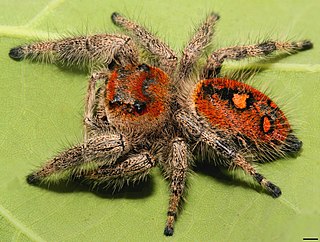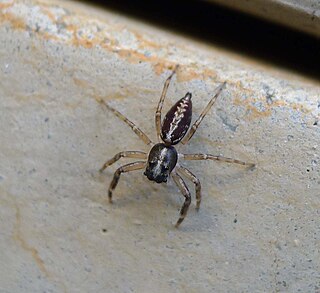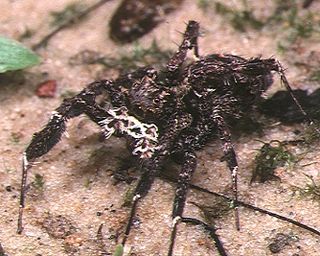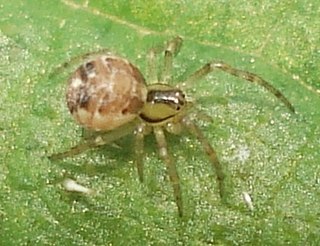
Austracantha is a genus of spider with a single species, Austracantha minax, commonly known as the jewel spider or the Christmas spider. It is a member of the family Araneidae and is endemic to Australia. They are relatively small spiders, reaching a maximum total body length of only around 12 mm (0.47 in) for females, and 5 mm (0.20 in) for males. Their abdomen has six distinctive projections ("spines") that makes them easy to identify. They are predominantly a shiny black, with variable white, yellow, and orange patterns. Melanistic forms also occur during autumn. They are facultatively gregarious, and can be found in large aggregations of overlapping orb webs. They feed on small flying insects that get entangled in their webs. They are harmless to humans, though the webs can be a nuisance for bushwalkers. They are most abundant during the summer months.

Phidippus audax is a common jumping spider of North America. It is commonly referred to as the daring jumping spider, or bold jumping spider. The spider belongs to the genus Phidippus, a group of jumping spiders easily identified both by their relatively large size and their iridescent chelicerae.

Phidippus regius, known commonly as the regal jumping spider, is a species of jumping spider in eastern North America.

Canama is a genus of spiders in the jumping spider family, Salticidae. Its five described species occur from Borneo to Queensland.
Cheliceroides longipalpis is a species of spider in the family Salticidae, found in China and Vietnam.

Epeus is a genus of the spider family Salticidae. They are often found on broad-leaved plants or shrubs of rain forest, or in gardens of Southeast Asia.
Euryattus is a genus of spiders in the family Salticidae.

Phidippus californicus is a species of jumping spider. It is found in the southwestern United States and northern Mexico.

Paratilapia polleni is a medium-sized cichlid endemic to Madagascar. It is also a popular fish for display at public aquaria.
Chrysilla lauta is the type species of the jumping spider genus Chrysilla. It occurs in rain forest from Burma to China and Vietnam. Although known since 1887, it has only been described from male specimens.

Pholcus phalangioides, commonly known as daddy long-legs spider or long-bodied cellar spider, is a spider of the family Pholcidae. It is also known as the skull spider due its cephalothorax resembling a human skull. This is the only spider species described by the Swiss entomologist Johann Kaspar Füssli, who first recorded it in 1775. Its common name of "daddy long-legs" should not be confused with a different arachnid species with the same common name, the harvestman (Opiliones).

Agalenatea redii is a species of 'orbweavers' belonging to the family Araneidae subfamily Araneinae.

Cyrtophora exanthematica are tent spiders common in tropical Asia and Australia. They are commonly known as double-tailed tent spiders because of the pair of blunt projections at the end of their abdomens. They are harmless to humans.

Carrhotus xanthogramma is a species of 'jumping spiders' belonging to the family Salticidae.

Portia fimbriata, sometimes called the fringed jumping spider, is a jumping spider found in Australia and Southeast Asia. Adult females have bodies 6.8 to 10.5 millimetres long, while those of adult males are 5.2 to 6.5 millimetres long. Both sexes have a generally dark brown carapace, reddish brown chelicerae ("fangs"), a brown underside, dark brown palps with white hairs, and dark brown abdomens with white spots on the upper side. Both sexes have fine, faint markings and soft fringes of hair, and the legs are spindly and fringed. However, specimens from New Guinea and Indonesia have orange-brown carapaces and yellowish abdomens. In all species of the genus Portia, the abdomen distends when the spider is well fed or producing eggs.
Ummidia algarve is a spider species found in Portugal. Unlike other known Ummidia species, it creates a trapdoor at the entrance of the burrow.
Zodarion bosmansi is a species of spider found in Portugal. Its colors are usually black or brown with orange-brown legs. Zodarion bosmansi Male has Pedipalp: tibial apophysis long, gently curved, terminally truncate. Prosoma and chelicerae light brown. Prosoma length: 2.03 mm. Legs yellow. Opisthosoma: dorsum sepia brown, venter pale. Body length of male: 4.08 mm and Zodarion bosmansi Female has Epigyne: median plate wider than long, anterior margin well marked with paired sclerotised lips. Colouration as in males. Prosoma length: 2.33 mm. Body length of female: 4.84 mm.
Antrodiaetus microunicolor is a species of antrodiaetid mygalomorph spider. It is found in the United States of America.

Phylloneta impressa is a species of comb-footed spider from the genus Phylloneta with a Holarctic distribution.
Diminutella is a genus of spiders in the family Sparassidae. It was first described in 2018 by Rheims and Alayón. It is a monotypic genus with one described species, Diminutella cortina. It is endemic to Pinar del Rio, Cuba.





















